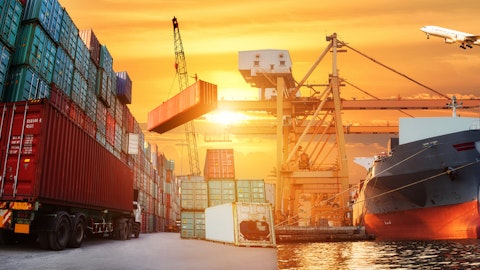Headcount is down 12% year-over-year. I mentioned our cost per drayage. We’re going to have far lower capital expenditures going into next year, and I think if you layer in some accretive M&A and the capital allocation plan, barring some sort of consumer recession we’re going to be targeting earnings and revenue growth. I think the only thing that remains unclear is the timing on recovery of demand, but we’ll certainly obviously have more specifics for you on the fourth quarter call, but I’ll let Brian and Geoff fill in.
Brian Alexander: Sure. Yes, no, Jason, I think what we see going into next year, and we talked a little bit about it earlier this year too about the inventories, and a lot of that inventory has to burn off more seasonally. So while there was some bloated inventories earlier this year, it just took a full seasonal cycle to burn off, and so as we push through the holiday season and enter into the spring we see that that’s going to be reset and in a good position to be replenished. And as we do that, we’ll see our intermodal volumes grow. We called out our brokerage, which is a standout in the marketplace. Despite all these market headwinds, they’ve stood out really well with that 5% growth and really continued growth going into next year as well.
And then our logistics services, we continue to see a really strong demand for all of our logistics services with our managed transportation, what we bring to the table, with our consolidation and fulfillment locations that I’ve mentioned that we’re adding and investing with new buildings. We’re working kind of left to right, adding two in the West earlier this year, two in the Midwest, and we’re going to finish out the year working into the East and going into 2024 as well as our Final Mile. So we continue to win service awards from our customers in our Final Mile offering. We’re bringing on new logos and diversifying that customer base. And our non-asset-based model in Final Mile has proven to be really great for flexing and growing with our customers, and so we’re going to see continued success there as we invest in that from a growth perspective.
But yes, those are the big areas that we’ll continue to focus. Phil mentioned a lot of the over-the-road conversions into the previous questions. There’s still over $56 million over-the-road truckload volume that’s out in the marketplace that is eligible for intermodal conversions, and we’re highly focused on delivering that on that growth and converting it in the right cost structure.
Jason Seidl: I appreciate those comments. How should we think about your rail partners? There’s obviously been some talk about improved rail service. I’m happy to see that, but I’m not giving them as much credit because we haven’t really seen the improved rail service with improved volume. So how confident are you guys, if we do see volumes come back at some point in 2024, that your rail partners will be able to handle that increase?
Phil Yeager: Yes. This is Phil. I think you’re seeing a good test right now with some sequential volume increase in pretty short order, which I think has been a good test. We’re hoping that this is more prolonged and continues to move forward. I agree with you. We have to continue to show our customers that, but at the same time, I think you’re seeing the commitment in hiring and resourcing to handle that demand, and so we believe we are going to be in that position. And it’s a massive opportunity for us and our rail partners, and I know all of our conversations are related to growth at this point in time.
Jason Seidl: Okay. Well, one final one, and I’ll turn it over to somebody else. And Phil, I think you mentioned accretive M&A. Can you maybe give us an update on the M&A market? Are you still seeing a lot of stuff being put up for sale, and what do the multiples look like, say, compared to a year ago?
Phil Yeager: Sure. I’ll start, and I’ll let Geoff go in. We haven’t seen as many companies coming up for sale just given some of the challenges in the broader market, and obviously interest rates increasing. And there’s been somewhat of a disconnect on overall value, but I think what we’ve been able to do is continue to go out and find interesting and exciting off-market opportunities, and we have a very strong pipeline right now and are certainly working towards closing something, we hope in the – in the near term.
Jason Seidl: Sounds good.
Geoff DeMartino: Yes. I’ll just add, it’s a key part of our strategic growth plan. We highlighted that today in the context of the overall capital allocation plan. I think we have a good pipeline, and we’re continuously evaluating. And again, we’ve had more success on those outreaches that we’ve generated, and we think we’re a good buyer in this market.
Jason Seidl: Thanks for the time, gentlemen.
Geoff DeMartino: Thank you.
Phil Yeager: Thank you.
Operator: Thank you. Our next question is from Brian Ossenbeck of J.P. Morgan. Please proceed with your question.
Brian Ossenbeck: Good afternoon. Thanks for taking the question. So maybe just to come back to competition on the intermodal side, so can you talk about more what you’re going after here? Is this really some of the things you think left the rail network with poor service, and this is really just over the road conversion? Maybe you can give some context in terms of where that spread is versus history. Is service good enough to get this back, or is this really more of a play on price and getting a little bit more of that density that you might have not had as much as you wanted before?
Phil Yeager: Sure. So I think you could imagine, given the market conditions, that it’s obviously a competitive marketplace. But I think what we’re seeing are very savvy customers are focusing on total cost, including fuel expenses and rate. And so we are seeing some nice conversions outside of bid cycles right now back to intermodal, taking advantage of the improved service product and some of those shorter hauls. When you think about the spread that we’re seeing between contract and – both from intermodal and over the road right now, in longer lengths of haul, it’s up near 40%. In the shorter lengths of haul, it’s getting closer to the high teens and 20 percentile, but in aggregate, really, in the mid 30s and so that’s what we’re trying to go to our customers both in advance of RFP events and enduring them, and highlight that differential as well as those strong service levels.



